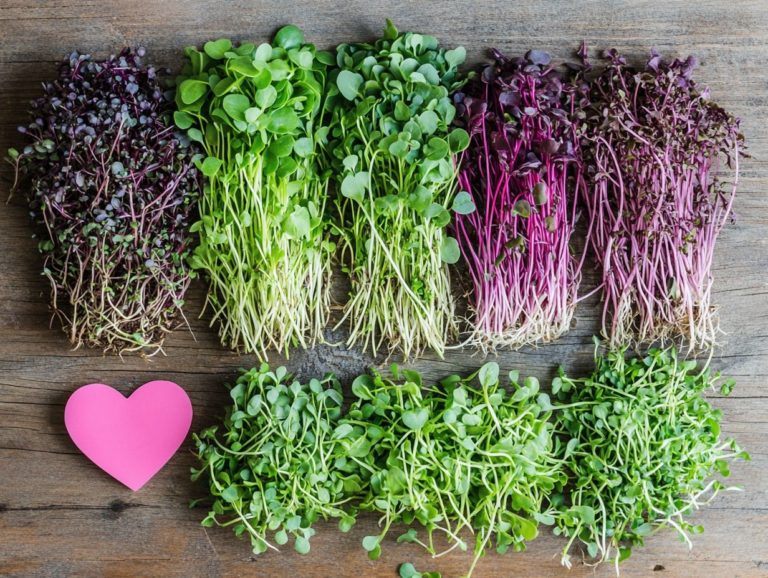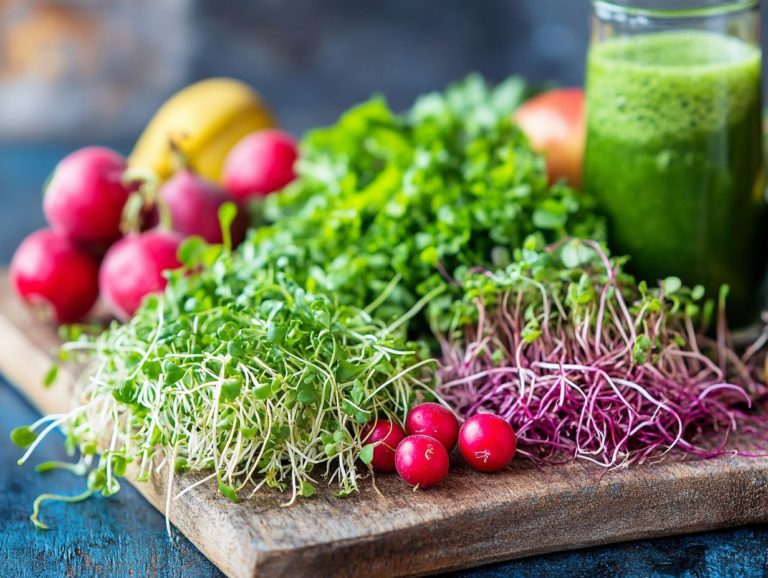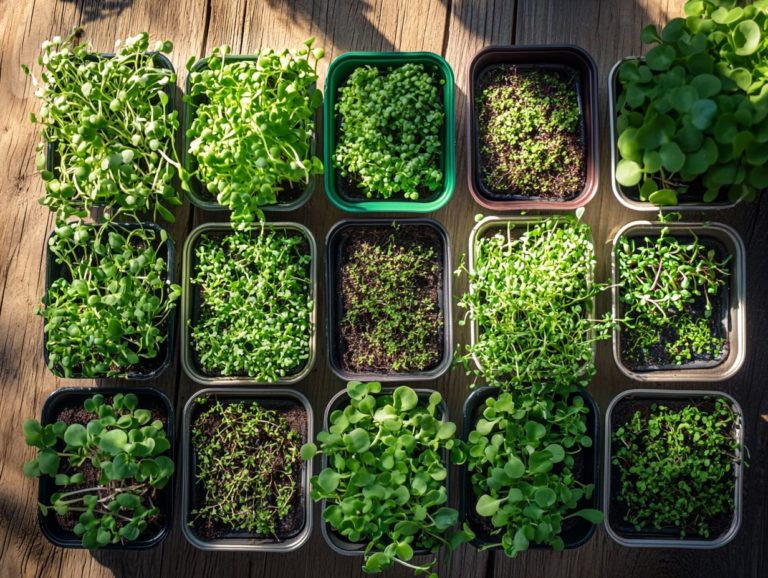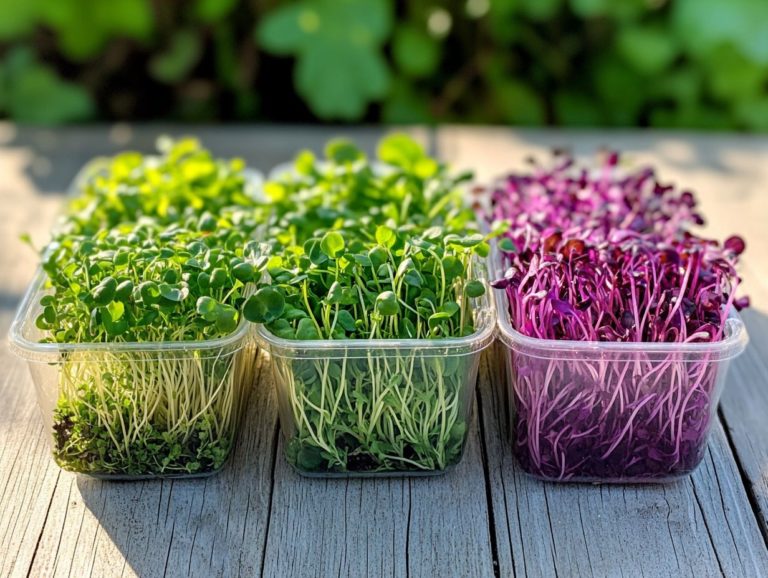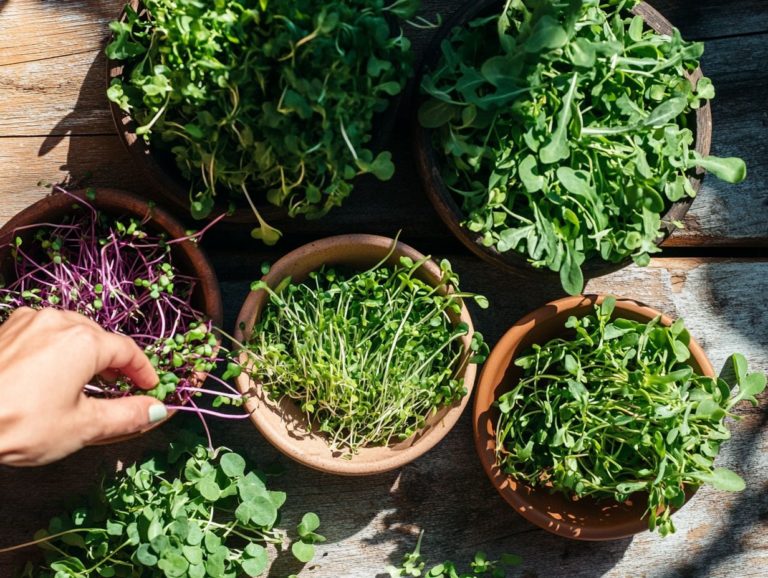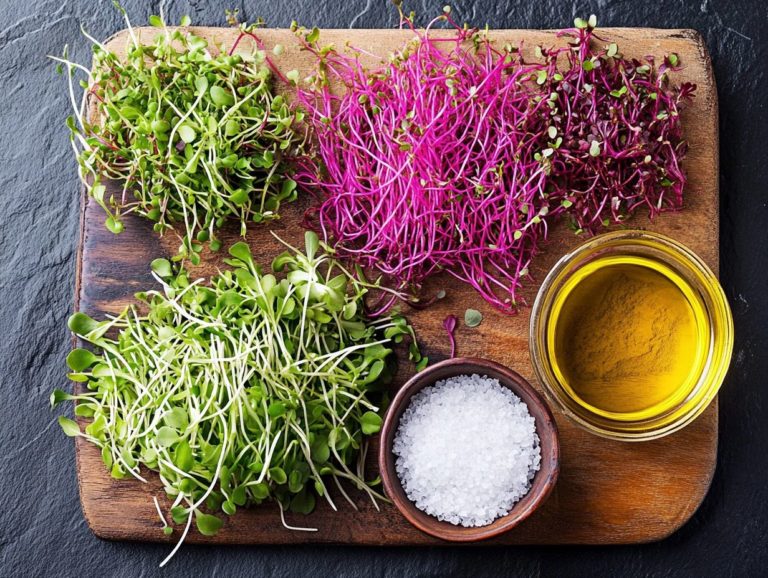5 Microgreens That Provide Essential Nutrients
Microgreens are the petite versions of your favorite greens, packed with an impressive nutrient profile within their delicate leaves. If you’re eager to elevate your diet with vibrant flavors and essential vitamins, you’re in for a delightful surprise.
This article delves into five powerhouse microgreens broccoli, kale, pea, radish, and sunflower each presenting unique health benefits. You ll learn what microgreens are, how their nutrient density compares to that of mature greens, and discover creative ways to incorporate them into your meals.
We ll also discuss how these tiny greens contribute to sustainability.
Discover how these greens can transform your health today!
Contents
- Key Takeaways:
- 1. Broccoli Microgreens: High in Vitamin C and Sulforaphane
- 2. Kale Microgreens: Rich in Iron and Calcium
- 3. Pea Microgreens: Packed with Protein and Vitamin K
- 4. Radish Microgreens: Good Source of Vitamin E and Zinc
- 5. Sunflower Microgreens: Contains High Levels of Vitamin B and Folate
- What Are Microgreens and Why Are They Beneficial?
- Frequently Asked Questions
- What are microgreens?
- What essential nutrients do microgreens provide?
- What are 5 microgreens that provide essential nutrients?
- How do broccoli microgreens provide essential nutrients?
- Why are sunflower microgreens beneficial for essential nutrients?
- How can I incorporate microgreens into my diet to get essential nutrients?
Key Takeaways:
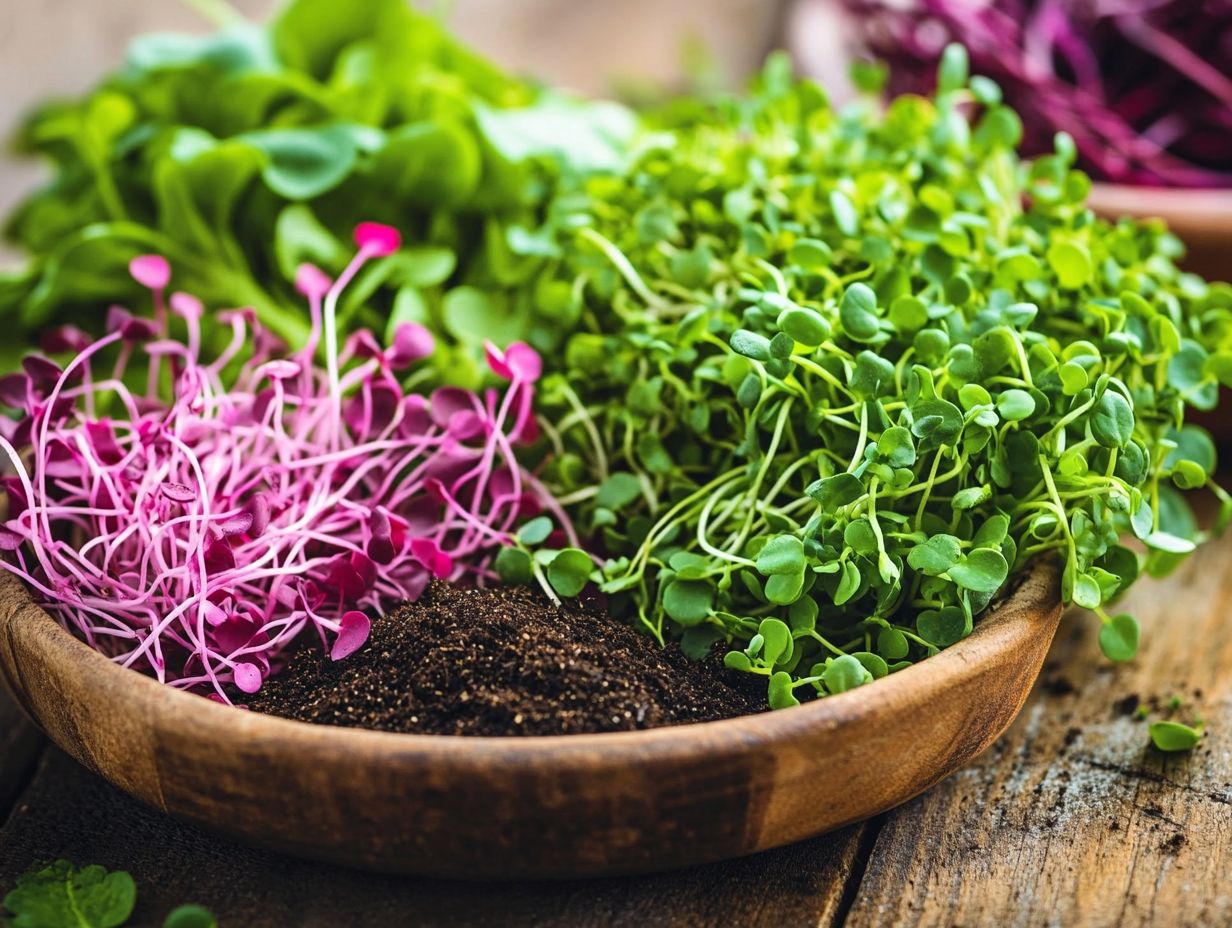
- Incorporate a variety of microgreens, such as broccoli and kale, into your diet for essential nutrients like Vitamin C, iron, and calcium.
- Pea and radish microgreens provide important nutrients like protein, Vitamin K, and zinc, while sunflower microgreens are high in Vitamin B and folate.
- Microgreens are a beneficial addition to any diet. They contain higher nutrient content compared to mature greens and offer sustainable benefits from growing them at home. It’s important to consume them in moderation and wash them thoroughly to avoid potential risks.
1. Broccoli Microgreens: High in Vitamin C and Sulforaphane
Broccoli microgreens are a true powerhouse of nutrition. They are rich in vitamin C and sulforaphane, a compound that may help fight diseases, contributing to impressive health benefits like disease prevention and antioxidant properties. They re an essential addition to your healthy, plant-based diet.
These tiny greens are more than just a pretty garnish; they significantly boost your immune system. Their high concentration of antioxidants fights off free radicals, enhancing your overall cellular health. Research shows that incorporating these microgreens into your meals can help reduce inflammation and improve immunity, especially during cold and flu season.
Their unique flavor adds a delightful crunch and nutritional punch to salads, sandwiches, and smoothies, making it easier for you to consume more greens. Just a small amount provides health benefits comparable to larger servings of mature broccoli.
Including broccoli microgreens in your daily meals is a wise choice for anyone aiming to elevate their well-being.
2. Kale Microgreens: Rich in Iron and Calcium
Kale microgreens are not just a tasty addition to your meals; they re a powerhouse of essential nutrients like iron and calcium. They transform your dishes into functional foods that support your overall health and wellness.
These tiny greens deliver a remarkable dose of vitamins A, C, and K, each playing a vital role in maintaining bone health by enhancing calcium absorption and promoting optimal bone density. Their impressive concentration of antioxidants can help combat inflammation and fatigue, providing you with a boost in energy throughout the day.
Incorporating kale microgreens into your meals is easy. Consider:
- Tossing them into salads for a delightful crunch.
- Blending them into smoothies for an extra nutritious lift.
- Using them as a vibrant garnish on soups and sandwiches.
Their versatility not only elevates the flavor of your dishes but also amplifies their nutritional benefits, making every bite a step toward better health.
3. Pea Microgreens: Packed with Protein and Vitamin K
Pea microgreens are a nutritional powerhouse, brimming with protein and vitamin K. They offer impressive health benefits and their delightful flavor elevates various dishes in a vibrant, plant-based diet.
With their high protein content, these petite greens play a crucial role in energy production, making them an ideal choice for anyone striving to maintain stamina throughout the day. For health enthusiasts, exploring the top microgreen varieties can enhance your diet. The vitamin K within them promotes healthy blood circulation and supports cardiovascular health.
Incorporating pea microgreens into your meals can be wonderfully effortless. Toss them into a fresh salad or let them add a crisp texture to your sandwich or wrap. For a touch of culinary creativity, try blending them into a pea microgreen pesto or mixing them into your smoothie. This nutritious boost will leave you feeling revitalized and robust.
Start adding these nutritious greens to your meals and check out the nutrient comparison of popular microgreen varieties to feel the difference in your health!
4. Radish Microgreens: Good Source of Vitamin E and Zinc

Radish microgreens offer a fantastic source of vitamin E and zinc. These nutrients promote skin health and strengthen immune function.
They also have a delightful peppery flavor that enhances your favorite dishes. These antioxidants combat oxidative stress and inflammation, which can harm your skin.
Incorporate nut-based spreads or vibrant salads topped with crunchy radish microgreens to boost your skincare routine. Think of blending kale with creamy avocado, a sprinkle of nuts, and radish microgreens.
This combination nourishes your body while tantalizing your taste buds. Toss them into wraps or sandwiches for an extra nutrition boost!
5. Sunflower Microgreens: Contains High Levels of Vitamin B and Folate
Sunflower microgreens are packed with vitamin B and folate. They are an excellent addition to your healthy diet.
These nutrients are important for energy metabolism and cellular health. By adding these microgreens to your meals, you boost flavor and texture.
Growing sunflower microgreens at home is easy and requires minimal investment. Just grab a shallow tray, fill it with nutrient-rich soil, and sow the seeds densely.
Keep them moist and place them in indirect sunlight. This method provides fresh produce quickly and helps the environment!
What Are Microgreens and Why Are They Beneficial?
Microgreens are young seedlings, such as broccoli, kale, and cilantro. They are packed with concentrated nutrition and health benefits.
These tiny greens contain significantly more vitamins, minerals, and antioxidants than mature vegetables. Studies show that microgreens can deliver up to 40 times more nutrients.
This is true for radish and mustard greens, known for their cancer-fighting compounds. The vibrant colors often indicate beneficial phytochemicals that help reduce inflammation.
Add these functional foods to your daily diet to enhance your meals and support your wellness journey!
How Do Microgreens Compare to Mature Greens in Nutrient Content?
Microgreens often boast a higher concentration of vitamins, minerals, and antioxidants compared to fully grown greens, making them an exceptionally nutrient-dense choice for health enthusiasts looking to elevate their meals.
For example, microgreens typically offer a richer source of vitamin A, which is crucial for maintaining eye health and supporting immune function. They also contain significantly more vitamin C, a vital antioxidant that enhances skin health and bolsters your immune system. Vitamin E protects cells from oxidative stress and is abundant in these young greens. If you’re looking to enhance your salads, consider trying some must-try microgreen varieties.
Get excited! Adding microgreens to your meals will not only boost your health but also make your dishes look gorgeous. They provide a burst of vibrant flavor and freshness that mature greens may lack. This makes microgreens an ideal addition to salads, sandwiches, and smoothies, while certain microgreen varieties that boost your immune system promote your overall well-being with every delicious bite.
What Are the Different Types of Microgreens?
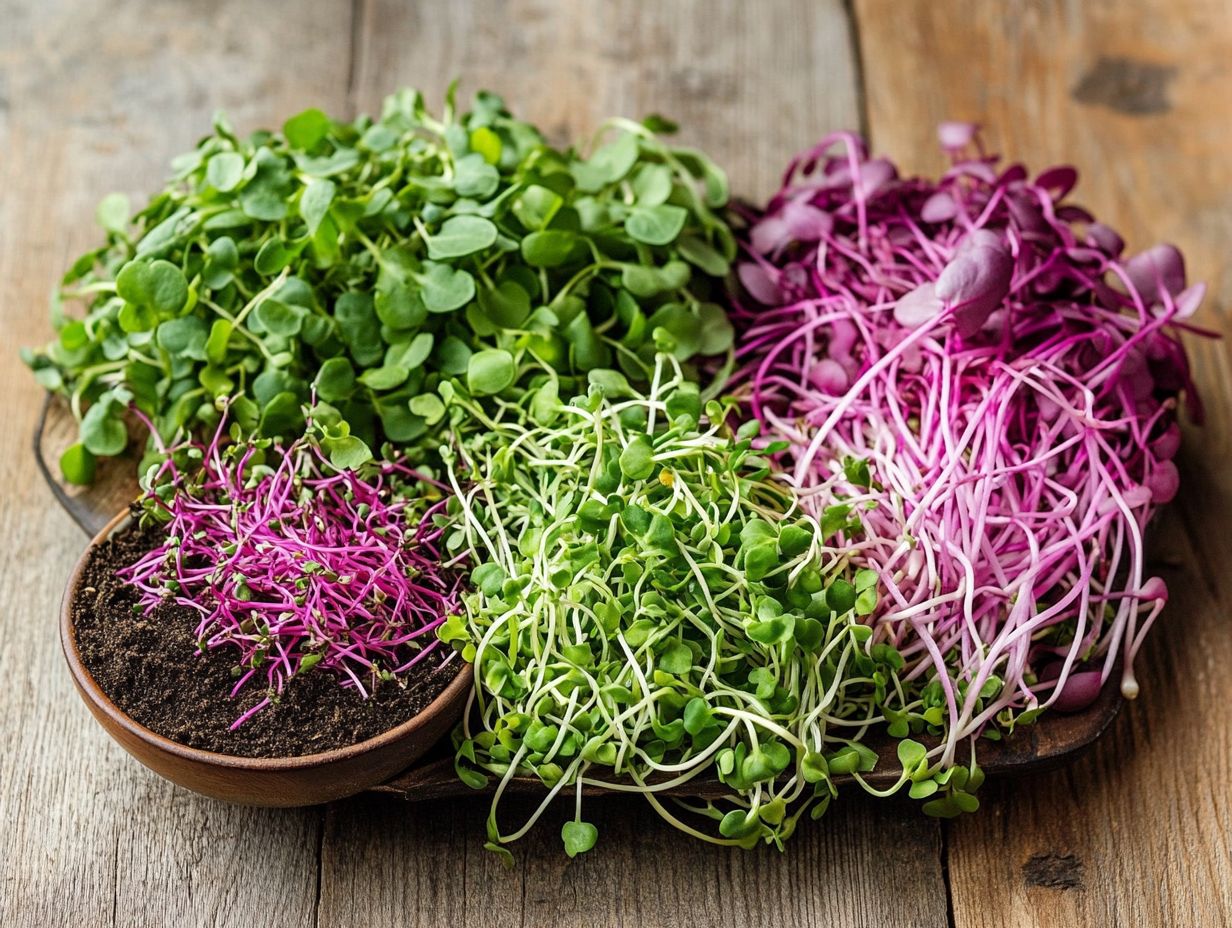
There s a world of microgreens waiting for you, with popular varieties like broccoli, kale, cilantro, and sunflower. Each brings unique flavors and nutritional benefits to your culinary creations.
These little greens don’t just add a splash of color to your dishes; they’re also nutritional powerhouses. For instance, broccoli microgreens are packed with a compound known for its impressive antioxidant properties. Kale microgreens are loaded with vitamins A, C, and K, all essential for your overall well-being. Cilantro microgreens offer a refreshing, citrusy zing that elevates salsas and salads. Sunflower microgreens present a mild, nutty flavor, perfect for enhancing sandwiches and wraps. To discover more about the best microgreens for nutritional value, check out this informative guide.
Growing microgreens at home is fun and rewarding! All you need are shallow containers filled with a quality growing medium, a bit of sunlight, and some moisture in the soil to encourage growth. This way, you can easily incorporate these nutritious little gems into your meals, right from your very own kitchen countertop.
How Can One Incorporate Microgreens into Their Diet?
Incorporating microgreens into your diet is both simple and delicious! Meal suggestions range from vibrant salads and hearty sandwiches to refreshing smoothies and elegant garnishes. This allows you to effortlessly enhance both nutrition and flavor.
These tiny greens are not just flavorful; they deliver a significant nutritional boost, offering a wealth of vitamins, minerals, and antioxidants. For instance, tossing a handful of radish microgreens into a fresh vegetable stir-fry not only adds color but also delivers a spicy kick that excites the palate. Incorporating top microgreens for smoothies can also enhance your dishes with added health benefits.
If you lean toward heartier fare, blend pea shoots into a creamy pesto to elevate a simple pasta dish into a gourmet experience. You can sprinkle these versatile greens over avocado toast for a nutritious breakfast or stir them into your favorite soup for an extra layer of depth.
Truly, microgreens present a convenient way to explore new flavor profiles while supporting a balanced diet.
Are There Any Risks or Side Effects of Consuming Microgreens?
While microgreens are widely celebrated for their safety and nutritional value, it s important to acknowledge some potential risks and food safety concerns tied to their consumption, especially regarding improper handling and growing conditions.
You should remain vigilant about these risks, as neglecting proper food safety practices can lead to contamination. Sourcing organic, food-grade seedlings is essential; non-certified varieties may carry harmful pathogens. Thoroughly washing microgreens before enjoying them can significantly mitigate the risk of foodborne illness.
When shopping for microgreens, seek out reputable suppliers who adhere to safety standards. Examine for any visual signs of spoilage. By understanding and following these guidelines, you ll not only enhance your microgreens experience but also safeguard your health.
What Are the Sustainable Benefits of Growing Microgreens?
Growing microgreens at home offers many sustainable benefits. You ll love discovering how to reduce your carbon footprint while enjoying fresh, local produce right at your fingertips.
Nurturing these little nutrient-rich plants in your kitchen or balcony can significantly lower the environmental impact of store-bought greens. This delightful practice fosters a variety of plant life in urban settings, attracting beneficial insects and enriching the local ecosystem.
If you re eager to start your microgreens garden, begin with small, shallow containers that have proper drainage. Seed trays or repurposed containers with lightweight soil will make it easy.
Regularly water and place these trays in a well-lit area or under grow lights. This simple hobby can transform into a rewarding experience that champions a healthier planet.
Frequently Asked Questions
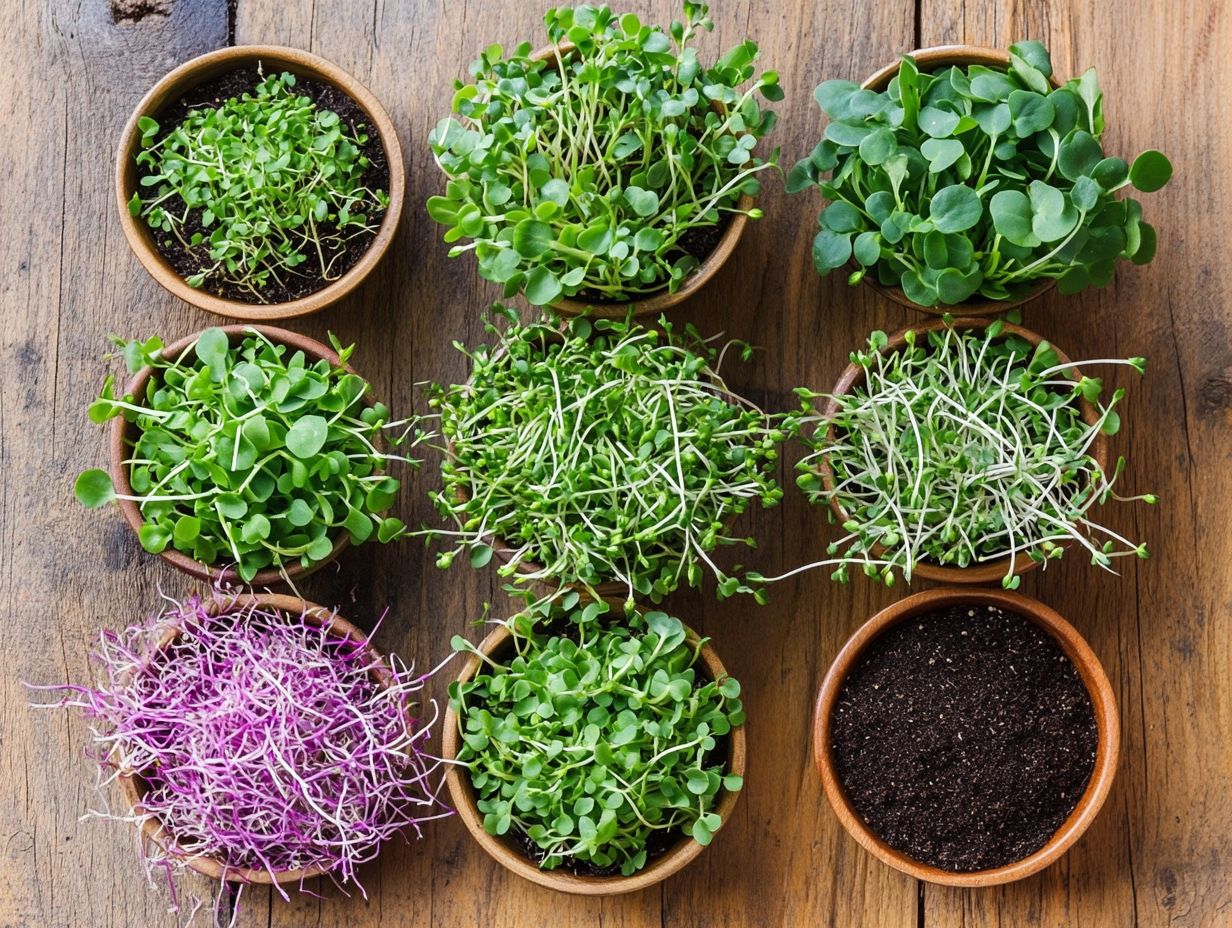
What are microgreens?
Microgreens are young vegetable greens harvested when they are about 1-3 inches tall. They are packed with nutrients and often used in salads or as garnishes.
What essential nutrients do microgreens provide?
They are rich in vitamins, minerals, and antioxidants, including iron, potassium, magnesium, and vitamins C, E, and K. Microgreens also contain protein, fiber, and healthy fats.
What are 5 microgreens that provide essential nutrients?
The five microgreens that offer essential nutrients are broccoli, kale, radish, sunflower, and pea microgreens. These nutrient-dense varieties are easy to grow at home.
How do broccoli microgreens provide essential nutrients?
Broccoli microgreens are great sources of vitamins A, C, and K, along with potassium, iron, and calcium. They also contain sulforaphane, which has anti-inflammatory and anti-cancer properties.
Why are sunflower microgreens beneficial for essential nutrients?
Sunflower microgreens provide vitamin E, crucial for healthy skin and eyes. They also contain essential fatty acids and beneficial phytochemicals.
How can I incorporate microgreens into my diet to get essential nutrients?
You can add microgreens to salads, sandwiches, smoothies, or use them as soup garnishes. They can also be juiced or eaten on their own for a healthy snack.

